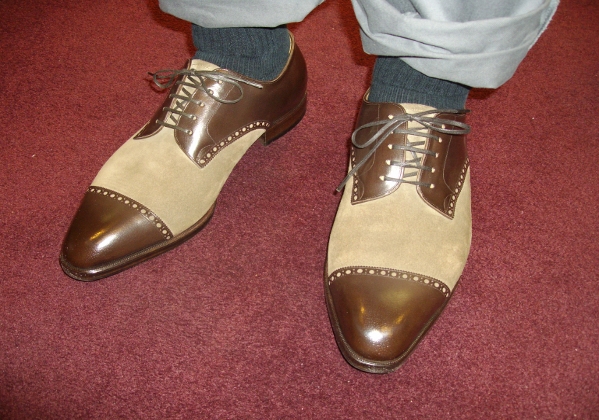 |
| Saion – Derby good for wide feet with high insteps |
There are many types of feet in this world, most of which would not be labeled as ‘normal.’ If you happen to be one of those people who was not graced with these wonderfully ‘normal’ feet (such as myself) then you may have at one point in your life wondered, “what shoe (and/or style) will suit me best in fit and comfort?” That’s the big question at hand and even though I am no podiatrist I will do my best to give you my opinion which is ultimately based on years of fitting all types of feet. Today we will focus on one’s instep (which will usually coordinate to width as well) and how the shape (and/or girth) of that instep will affect the types of shoes that will accommodate your feet. And for those that may not be familiar with the term ‘instep,’ it is the top part of your foot, where the laces of your shoes touch. So, basically there are three types of insteps: High, Low and Normal. This may seem painfully obvious to the select amount of you shoe connoisseurs that read my blog, but for a great deal many, it certainly is not. So here we go:
High Insteps:
From what I have seen in my life and all of the different people that I have fit, from culture to culture, this seems to be the problem that affects most. Many cultures out there, like those from South America as well as Europe (particularly British people) suffer from high insteps, which ultimately means that the person also has a high arch, as indicated in the picture. What usually tends to come along with these two things as well is a broad ball of the foot, i.e. the joints where your toes meet the rest of the foot. But just because the instep is high and the ball of the foot is broad, does not necessarily mean that the foot is considered “wide” as this type of foot very well may have a narrow ankle. This is where the problem occurs, because as the foot needs accommodation for that broad forefoot and that high instep, it does not really serve to get an overly wide-fitting shoe as the heel will be very sloppy and will nearly pop out at every step. So what do you do? Well, without getting to complicated and going for custom shoes, you have to think about what style fits best and that will ultimately be the: Derby (or Darby). A derby is an open laced shoe that gives more flexibility in the instep as the vamp extends to the tongue, all as one piece. Because of this, a high instep foot will have an easier time getting into, as well as being comfortable in this model.
Shoes That Should Fit: High volume shoes (a lot of girth/space inside the shoe), derbys, chukka boots, low cut loafers, single monk straps, suede shoes (leather is softer), chelsea boots, jodhpur boots
Shoes To Avoid: Oxfords, balmoral boots, double monk straps, high cut loafers, anything with an inflexible band/strap across the vamp
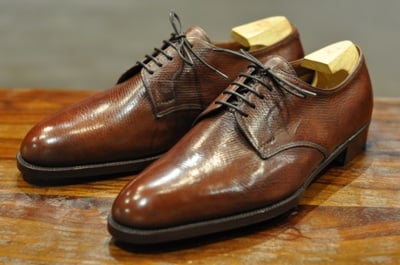 |
| George Cleverley, Picture Courtesy of Leather Soul |
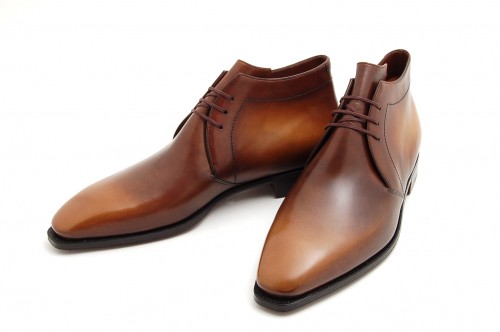 |
| Corthay, Picture Courtesy of Leffot |
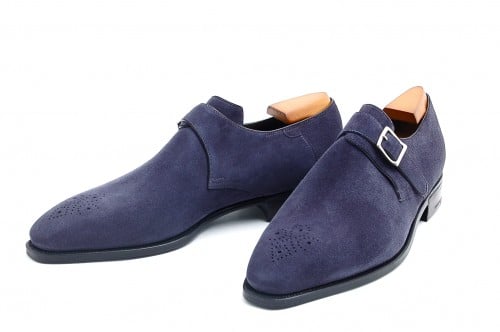 |
|
| Corthay, Picture Courtesy of Leffot |
Low Insteps:
A low instep is probably the least common of all the feet but leaves the wearer with the most problems, as most shoes are made to accommodate medium-to-high insteps and therefore leaves a lot of room to be filled inside the shoe, once the foot is in it. This is the problem that I have, but on top of this I also have a narrow foot, making it a triple-whammy! I don’t believe however that all flat arches correlate to a low instep nor a narrow foot (as many people from an African origin have flat feet, but are not low in the instep nor are narrow), so we will assume that from this point forward, we are strictly speaking about a low instep and what the person should do and/or wear for this problem. Because a foot of this nature is very low in height (from floor to top of foot), it needs shoes that tend to be less voluminous and more shallow in depth. This is the tricky part however, as many shoes are not as inclined to be designed as such. But there are models that are going to be more accommodating to this problem than others, such as the oxford. The oxfords’ design, with a closed lacing system and a general minimum of 5 eyelets, leads to the wearer being able to tighten it in such a way that locks/holds the foot in place more so than any other model. Another model that can accommodate quite well if made in a such a way, is a loafer with a high cut tongue piece. But this will very much depend on the depth of the loafer, as it can be made for a medium to high instep as well….
Shoes That Should Fit (presuming a low volume design): Oxfords, balmoral boots, high-cut loafers, double monk straps
Shoes To Avoid: Low-cut loafers, derbys, single monk straps, chelsea boots, jodhpur boots
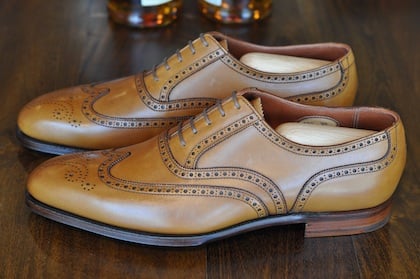 |
| George Cleverley |
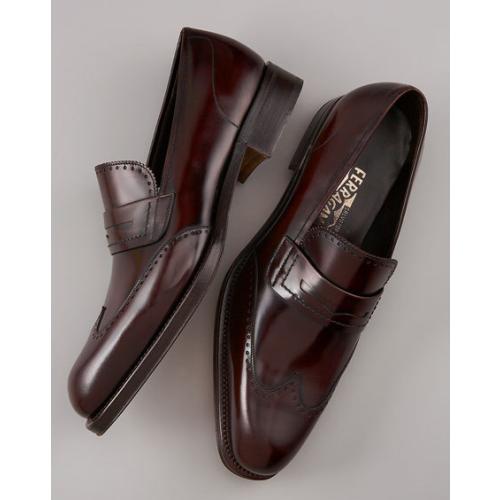 |
| High Cut loafer by Ferragamo |
Normal Insteps
Fortunately for the few of you that actually have this type of foot, you really don’t have anything to worry about. As any model of shoe should be able to accommodate your normal feet, the only thing that you will have to look out for is making sure that the last in which the shoe model was made off of, was made to a normal standard. What I mean by this is the fact that some makers, like Ferragamo, will make the majority (at least the ones sent to the States) of their shoes to a certain standard, like narrow. Therefore, while your foot may be normal and easy to fit, you might have a hard time fitting a Ferragamo as they are made a bit on the narrow side….other than this problem, you are scott-free!
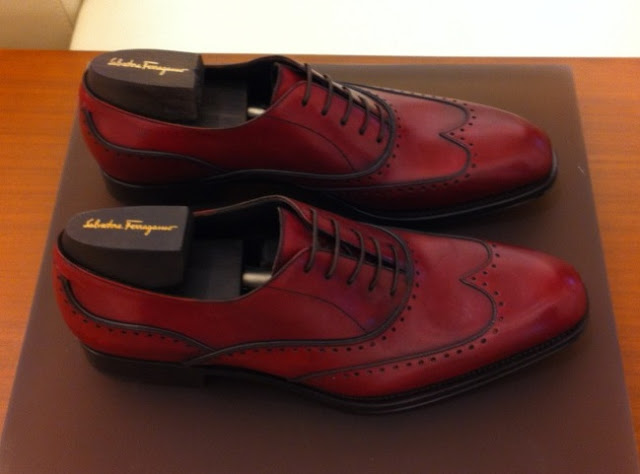 |
| Ferragamo |
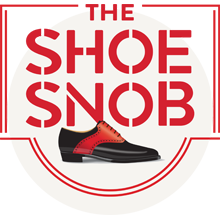
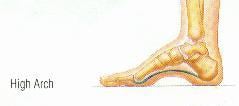
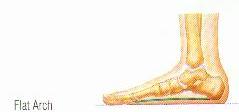
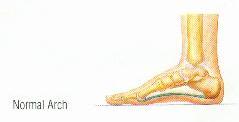


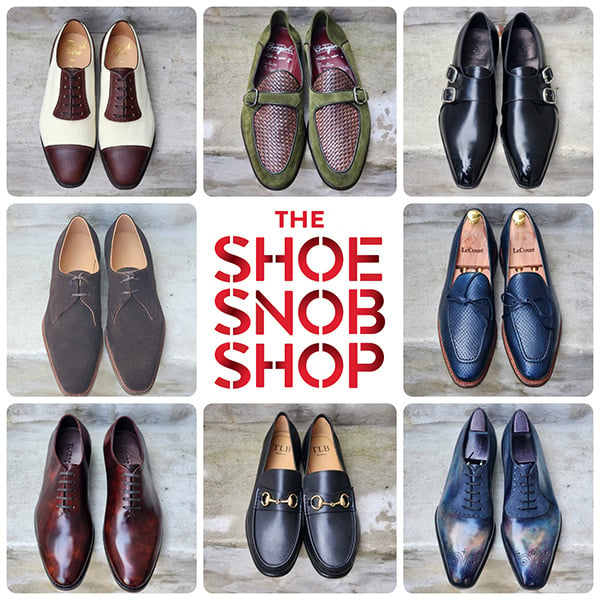
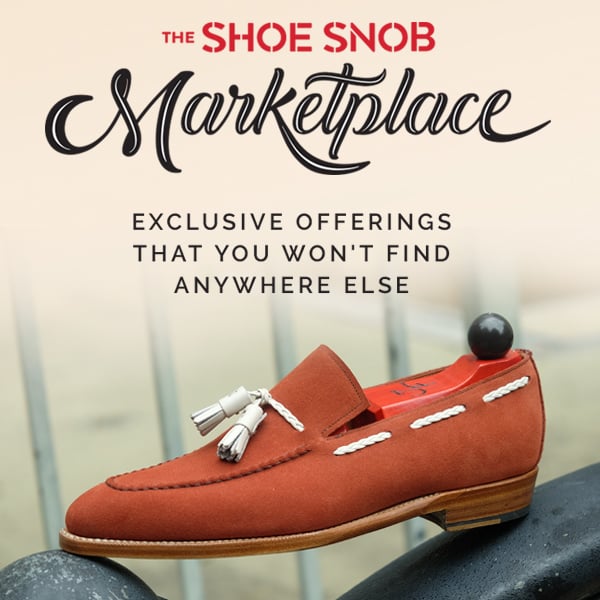

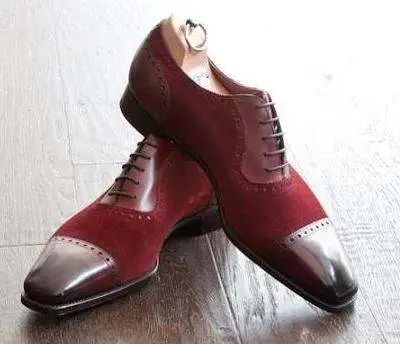
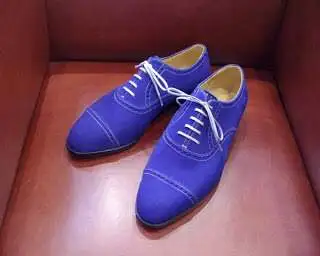
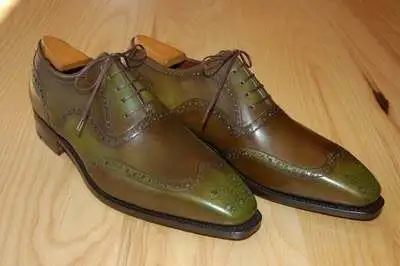
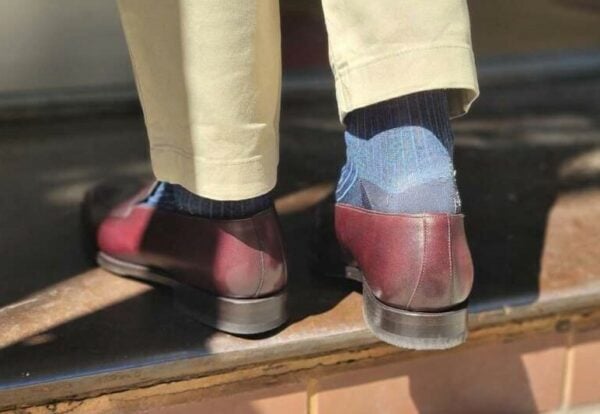
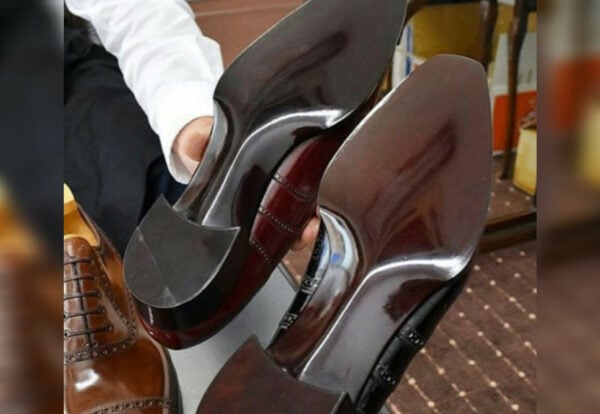
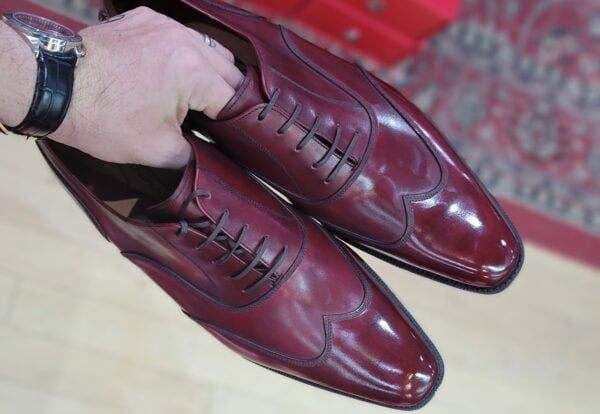
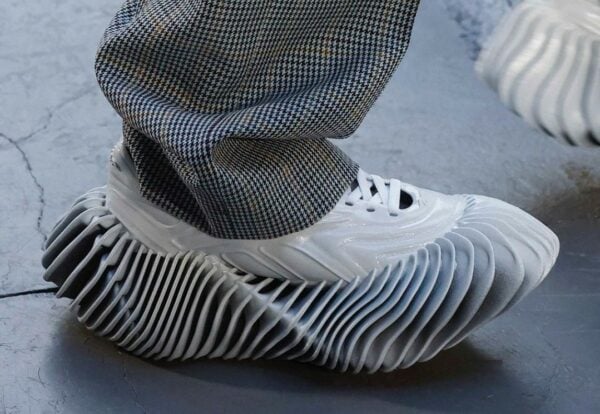
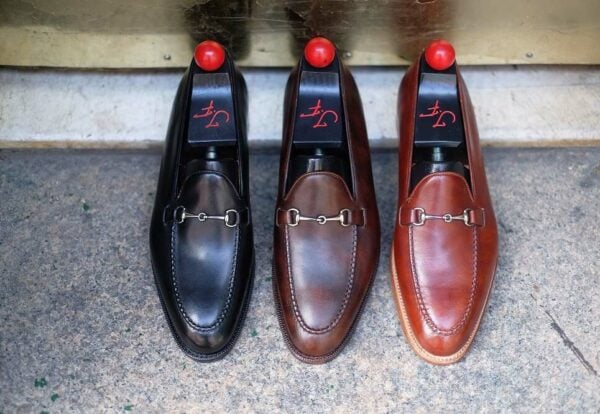
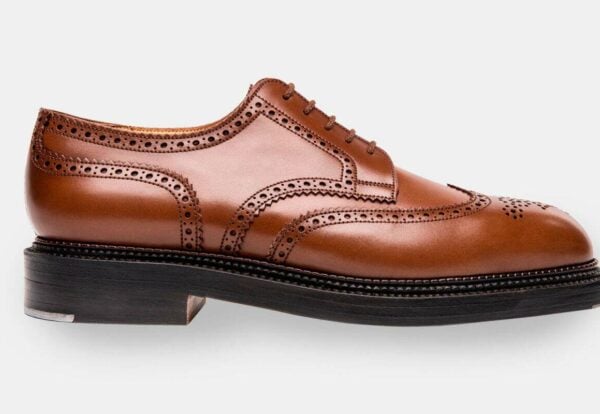
I myself, have a HIGH instep, and a completely FLAT foot, which is also wide enough to register at nearly 11 EEE. So I’m pretty much screwed right? Yeah, it’s why I have either gone bespoke (ouch to the wallet) or, ::SIGH::, upsized with pads, inserts, etc.
Where are you finding these beautiful Ferragamo’s????
Miles, you want to buy some fantastic double monks?! I have a similar foot but they’re just a bit too big for me.
http://www.ebay.com/itm/110937142688?ssPageName=STRK:MESELX:IT&_trksid=p3984.m1586.l2649
If you do, I’m happy to work something out off eBay. They’re stunning shoes, brand new in the box, and way cheaper than bespoke!
Ahem!
Anyway, sorry for the digression again, Justin, nice piece! Rather like Miles, I have a wide foot and a slightly high instep, but not a high arch. I’ve found recently that super-wide is not the answer (too loose around the heel etc.), so for me it’s a normal wide in a derby/single monk, or a half size up for an oxford. As near as I can get until bespoke becomes affordable!
Next attempt will be a semi-bespoke/MTO I think…
Think this is a v helpful post for many people Justin. Ive got a fairly high instep but find a double monk strap is actually quite good for this issue as the vamp and tongue are one piece (as you mentioned with the derby shoe).
You pointed out that the double monk isn’t good for a high intep where as the single monk is, however, I have actually found the reverse to be true as on a single monk the main holding strap is usually wide and placed higher up on the shoe. However with the double monk the lower strap is the main fastening one with tension on it and is lower placed, with the higher one placed in a manner merely to hold the piece which folds over across the vamp in a neat way and this piece is usually placed in a way which leaves generous space between it and the vamp (especially the upper half). Seems counter intuitive but I would suggest anyone with a high instep doesn’t disregard the double monk as a serious option, of course with any monk strap you can also adjust the strap to a give less tension across the vamp as well. Anand
Anand – I think you have a point. However, I do find that the range of adjustment on a double monk can be limited – or none at all on a lower strap – and affect the overall shape somehow. But with a single monk, the strap is often held on hidden elastic, which makes it very accommodating and comfortable.
You’re right about double monks in general though, I’m sure. I think the main rule for those of us with higher/wider feet, or anyone I suppose, is to try on a lot of shoes!
Myles K – Well, while you might think so, you always have Allen Edmonds to fall back on! Their split toe derby would be very accommodating for you!
Derrick C – Sorry to disappoint, but these are all very old….brought them out of the woodworks as they are among the best I have seen of ‘ol Gamo…
Alex B – I shall look forward to the day you do finally go bespoke and seeing what you come up with!
Anand – Thanks for sharing Anand…I stated double monks because I have always seen people whom had high insteps but wearing double monks, not close the top buckle as it put too much pressure on their foot…. Definitely did not mean to deter people from buying them, but more as cautionary advice for what might fit best.
-Justin
Justin,
Do you have any recommendations for the “Asian foot?” I have a wide foot but not a wide ankle. I have a low arch but I’m not flat footed. It doesn’t look like I have a high instep but I feel pressure up top when wearing oxfords. It sounds I might fall into the derby category.
derby or bespoke…to be honest, the “asian” foot is a hard one to make as the forefoot is broad but the ankle is not…tough that one!! G&G have quite a narrow ankle but make wide widths…same as EG….buy as per style, yes Derby would be best
why not just get a G fitting?
Justin – Besides bespoke or derby, would whole cuts work? Like an all leather one piece soccer cleat, the thought is that it will expand to my feet due to the lack of seams or multiple layers of leather that makes the shoe harder to give.
kevin_lee – the wider fitting is good for the forefoot but not my ankle. I have skinny ankles and it would just slide around.
yea you could try a wholecut too I guess, but you might find it tight on your instep, that can sometimes be the problem with them…
I have a wide forefoot, narrow heel, lowish instep and feet that are basically between an 8 and 9 UK size in length/forefoot width (if reasonably wide fitting), but with a heel that only starts to fit OK at about a size 6-7 (I have attached a pic). I am so frustrated that I think I will end up going bespoke despite the cost after years of putting up with poor fitting shoes or wasting money on shoes that end up being unwearable. I’ve tried every modification and tip there is but if a shoe isn’t the right fit no amount of faffing around will make it fit properly. It has got to the stage that no longer trust my own judgement as to whether what I am buying is too small or too big in my search for a workable compromise. I have to wear steel cap workboots as well which as you can imagine is a challenge.
In my search for information I occasionally came across the mention of shoes made on a “combination last” but further research seemed to throw up suggestions this is a discontinued practice in mass produced shoes and other comments that they never really existed and that it is a myth. I find so many comments online about people struggling with feet like mine and personally know several people with this problem so I wonder why a manufacturer somewhere in the world doesn’t make at least one good general purpose shoe with this sort of width variation. I have tried some that claim to make shoes like this (Australian manufacturer Ascent, which makes affordable work/school shoes) but these are inevitably just plain wide rather than properly wide/narrow front to back. Ascent claims that “my” type of foot is common in Australia (where I live) but either my feet are way to freaky or they just didn’t try hard enough. Actually I have got better fits with other shoes so I think they just didn’t try hard enough.
I think if the shoe manufacturing industry doesn’t believe it is a big enough market to bother with a model like this I would ask “How do you know?”. I think there is a overlooked market out there dying to pay good money for a shoe that won’t either rub the heel or crush the toes as so many like me have to compromise with now.
I am sorry for all of the troubles that you seem to have had throughout your life….seems like a tough issue…do tell how the bespoke goes for you, unfortunately for some that is the only route…
for a flat foot, what are your thoughts about beveled waists?